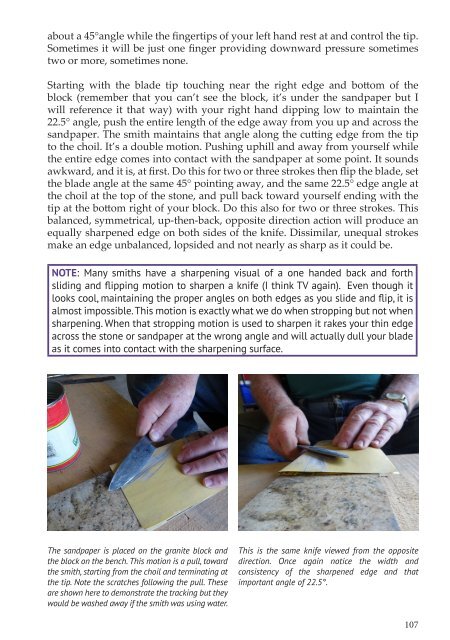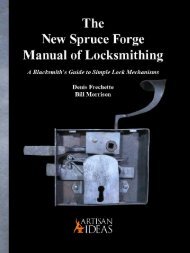FORGED: Making a Knife with Traditional Blacksmith Skills
This book will teach you to hand build a knife using the traditional method of blacksmiths of old — FORGING. Traditional forging of a knife blade is a process which uses the ancient techniques of moving hot steel with hammer and anvil alone into a knife-form that is ready for filing, heat treating and sharpening with no or very minimal electric grinding. This book also teaches traditional fit-and-finish skills using only hand tools. It explains an ancient riveted full-tang handle construction system that surpasses modern methods. In the author's words; "In my early blacksmithing years, I was lucky to get to know some old smiths who wrangled hot iron every day just to make a living. They unselfishly taught me traditional blacksmithing skills and knife forging methods. Every time I use those skills and methods, I honor their friendships, and by teaching you, the reader, we keep alive the memory of those old-time iron pounders." Hardcover, 132 pages, 150 photos and illustrations, $29.95.
This book will teach you to hand build a knife using the traditional method of blacksmiths of old — FORGING.
Traditional forging of a knife blade is a process which uses the ancient techniques of moving hot steel with hammer and anvil alone into a knife-form that is ready for filing, heat treating and sharpening with no or very minimal electric grinding.
This book also teaches traditional fit-and-finish skills using only hand tools. It explains an ancient riveted full-tang handle construction system that surpasses modern methods.
In the author's words; "In my early blacksmithing years, I was lucky to get to know some old smiths who wrangled hot iron every day just to make a living. They unselfishly taught me traditional blacksmithing skills and knife forging methods. Every time I use those skills and methods, I honor their friendships, and by teaching you, the reader, we keep alive the memory of those old-time iron pounders."
Hardcover, 132 pages, 150 photos and illustrations, $29.95.
Create successful ePaper yourself
Turn your PDF publications into a flip-book with our unique Google optimized e-Paper software.
about a 45°angle while the fingertips of your left hand rest at and control the tip.<br />
Sometimes it will be just one finger providing downward pressure sometimes<br />
two or more, sometimes none.<br />
Starting <strong>with</strong> the blade tip touching near the right edge and bottom of the<br />
block (remember that you can’t see the block, it’s under the sandpaper but I<br />
will reference it that way) <strong>with</strong> your right hand dipping low to maintain the<br />
22.5° angle, push the entire length of the edge away from you up and across the<br />
sandpaper. The smith maintains that angle along the cutting edge from the tip<br />
to the choil. It’s a double motion. Pushing uphill and away from yourself while<br />
the entire edge comes into contact <strong>with</strong> the sandpaper at some point. It sounds<br />
awkward, and it is, at first. Do this for two or three strokes then flip the blade, set<br />
the blade angle at the same 45° pointing away, and the same 22.5° edge angle at<br />
the choil at the top of the stone, and pull back toward yourself ending <strong>with</strong> the<br />
tip at the bottom right of your block. Do this also for two or three strokes. This<br />
balanced, symmetrical, up-then-back, opposite direction action will produce an<br />
equally sharpened edge on both sides of the knife. Dissimilar, unequal strokes<br />
make an edge unbalanced, lopsided and not nearly as sharp as it could be.<br />
NOTE: Many smiths have a sharpening visual of a one handed back and forth<br />
sliding and flipping motion to sharpen a knife (I think TV again). Even though it<br />
looks cool, maintaining the proper angles on both edges as you slide and flip, it is<br />
almost impossible. This motion is exactly what we do when stropping but not when<br />
sharpening. When that stropping motion is used to sharpen it rakes your thin edge<br />
across the stone or sandpaper at the wrong angle and will actually dull your blade<br />
as it comes into contact <strong>with</strong> the sharpening surface.<br />
The sandpaper is placed on the granite block and<br />
the block on the bench. This motion is a pull, toward<br />
the smith, starting from the choil and terminating at<br />
the tip. Note the scratches following the pull. These<br />
are shown here to demonstrate the tracking but they<br />
would be washed away if the smith was using water.<br />
This is the same knife viewed from the opposite<br />
direction. Once again notice the width and<br />
consistency of the sharpened edge and that<br />
important angle of 22.5°.<br />
107










